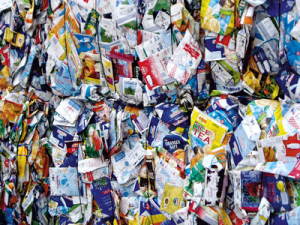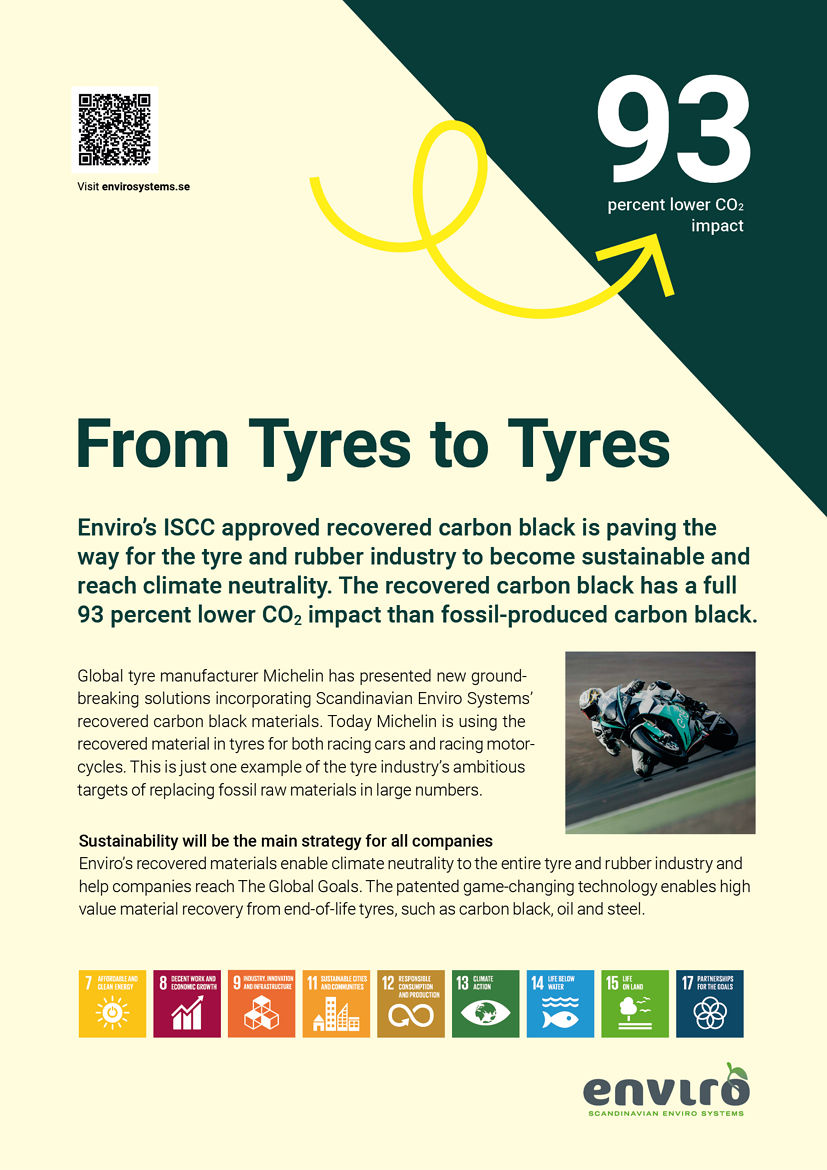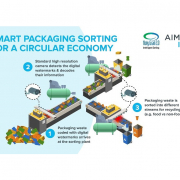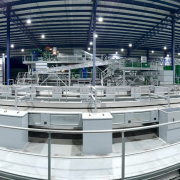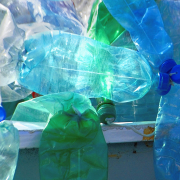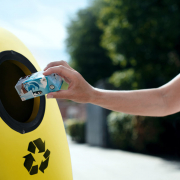PolyAl: A Twitter Forges Ahead
The recycling of used beverage containers like TetraPak is difficult. Parts of these liquid food cartons are compounds, arduous to separate and to recover sorted. Even after recovering 75 percent of cardboard, a foil mixture of polyethylene (PE) and aluminum (AL), as well as high-density polyethylene (HDPE) originating from the caps, remains. Is this mixture called PolyAl recyclable?
The Dutch industrial designer Dave Hakkens is skeptical: In his eyes, “plastic-aluminum mix is usually moist, and may have parts of paper fiber, and other materials such as metal, sand, glass and wood coming from the household collection streams”. The material is said to be bulky and heavy as it often contains water, which increases expenses so that the logistics costs are high compared to the material value. Accordingly, this so-called reject in earlier days has mostly been thermally used in cement plants or could only be converted into few products after extrusion. On the other hand, the material properties of PolyAl compared to LDPE show a slightly higher heat conductivity, a unique and sparkly appearance, and an aluminum content (up to 20 percent) that may affect mechanical properties but is generally not an obstacle for extrusion.
Gasification plant Corenso closed
There can be no doubt that the industrial handling of the material causes difficulties. Packaging blogger Bruno Rey characterized the situation in June 2018 like this: “Today, only about half of the globally available plastic-aluminum mix is recycled, and it presents a series of problems: very few uses, variable quality, logistic costs.” Obstacles occurred by separating aluminum and LDPE at the deployment of two Stora Enso facilities, for example.
In 2001 Corenso, owned by paper giants Stora Enso and UPM-Kymmene, opened a recycling plant using a bubbling fluidized-bed gasification technology developed by VTT (Technical Research Centre of Finland) in Finland. The plastic was turned into gas, and the aluminum was removed from the gas as a fine powder. Aluminum recovery from the process was specified at about 3,000 tons a year. The resulting material was said to be fit for the metal industry. But it contained coal-like particles, required further reprocessing, and could additionally be hampered by oxidation. The plant closed in 2010. Today, Corenso is a European and Chinese supplier of coreboard and cardboard tubes.
CLEAN – a LIFE Project
The progression of another Stora Enso plant suffered a similar fate. The Finnish producer of paper and cardboard packaging resorted to a new pyrolyze plant in Barcelona and the use of confectionary production waste, in partial replacement of virgin cellulose, the so-called ECO paper. Bruno Rey commented that “the evaporated gas can be used to generate electricity while the aluminum remains un-oxidized and can be recycled and remelted without problems to be used to make new aluminum products”. The aluminum was left in the reactor as small flakes, that were cooled down, cleaned up (by filtering), compressed into briquettes, and sold back to the aluminum industry as a raw material. The technique executed and titled “CLEAN – Converting Laminates into Energy and Aluminium for the benefit of Nature” was even a LIFE Project, supported by the EU in 2010. The team planned to build and operate “Europe’s first facility that can fully recycle brick cartons” and foresaw the construction of three plants in the next five years.
Barcelona Cartonboard plant sold
But in 2015, Stora Enso decided to focus on “high-quality virgin-fiber products” instead of “recycled-fiber-based consumer board” and divested its Barcelona mill, which closed in 2016. Stora Enso’s head of division Jari Latvanen argued: “Despite positive results development in recent months, the Barcelona mill requires further development effort and investment if it is to remain on a profitable path. I believe that the mill can operate more efficiently under the new ownership.” (Barcelona Cartonboard was signed over to Munich-based private equity fund Quantum. Two years later, it was signed over to the Reno De Medici Group, Europe’s second-largest producer of carton board made of recycled fibers.)
Resistant to mold and mildew
These samples not only illustrate that in 2015 the separation into two streams of polymers films and aluminum flakes was at least “done in relatively large scale in a few countries (e.g. through gasification in Finland or pyrolysis in Spain)”, as Dave Hakkens gave account. They also prove that for the beverage carton recycling branch PolyAl recovery was (and is) not primarily targeting the recycling of aluminum. NBR, for example, a Spanish recycling company, recently invested in a technology to turn used plastic into plastic pellets to be sold. In cooperation with TetraPak, NBR tested the best use for the material – making plastic pellets or other products such as ACM boards and injected hoses. French Guéry SAS delivers a special PolyAl – the material is described as “highly resistant to impact, weathering, oils, dyes and acids”, water-repellent, resistant to mold and mildew, and 100 percent rot-proof.
TetraPak cooperation
Moreover, the international cooperation of TetraPak demonstrates the use of PolyAl first of all for plastic and paper purposes. Since 2007, TetraPak has been working with the Brazilian recycler Revita and recently invested in a new process on Revita’s plant, which increases the capacity to process and clean PolyAl. Malaysian Think City KL, a partner since February 2018, recycled PolyAL panels and tiles to build concept micro houses. Newly installed equipment at BioPappel, the biggest manufacturer of paper products in Mexico and Latin America, now also allows the recovery of up to 85 percent of PolyAl from used duplex beverage cartons. And since more than ten years, Indonesian PT. Leo Graha Sukses Primatama recycles used beverages cartons into recycled paper; in 2018, they started recycling the polymer and aluminum layers of these cartons into roof sheets.
Brazil producing roofing tiles
Many recycling activities for used beverage cartons in Brazil led to the same final result: In 2019, a total of 15 companies processed PolyAl to produce roofing tiles and plates. The biggest recycler of Tetra Pak used beverage cartons in Brazil has 18 machines installed and a capacity to treat 400 tons of PolyAl per month. Tetra Pak helped to develop the system and is also involved in the production process. Among the Brazilian companies, the plasma-based melting process developed by Alcoa Aluminio and TSL Ambiental stands out. A scientific article on the pyrolysis of TetraPak characterizes their facility as “the first plant in the world that can separate the paper, aluminum and plastic components used in packaging cartons by using plasma technology”. According to one source, the 1,500°C plasma melted aluminum was contaminated with residual fibers, and so the operation was ceased in 2010. But another source tells of temperatures up to 2,000° C that still enable liquidation, low concentration and recycling of both Al and Al2O3.
Global demand for PolyAl
The material of PolyAl is going to be needed globally – in a wide range of processing and recycling materials. In South Africa, retail designer and manufacturer Barrows Global created a new product out of PolyAl. Unlike temporarily usable units made of corrugated board and plastic, the company delivers a display with a permanent upcycled core structure. “The Barrows’ vision is to divert 35 million long-life cartons from landfill in PolyAl units”, the Engineering News gave account. Also reusable for other presentations, the material requires 90 percent less corrugated board, needs 37 percent carbon, and saves up to 20 percent of costs; the displays are to be uplifted and recycled into new units at the end of 24 months. In Australia, Re>Pal company with its main factory in East Java, Indonesia, uses a unique and trade marketed technology process called ThermoFusion that delivers “zero waste pallets made from 100 percent waste plastic”. The company is sure to re-recycle TetraPak material into Re>Pal pallets ad infinitum with other materials or new TetraPak recycled material. In Malaysia, the Careton Project started in 2012. Since then, it provided enough roofing tiles and panel boards – recycled from Tetra Pak – to build over 150 homes and community infrastructures. In 2019 the team planned to recycle and convert drinking packs into about 1,000 PolyAl panel boards.
An investment in the future
In the Netherlands, Fauna Birdproducts BV put some products such as bird feeders on the market made from PolyAl by Recon Polymers BV, an environmentally aware Roosendaal located start-up. In Germany, Palurec GmbH, founded as a wholly-owned subsidiary of Fachverband Getränkekartons für flüssige Nahrungsmittel e.V. (FKN), has invested in the construction of a recycling plant, targeting a recycling rate of beverage cartons to far beyond 90 percent. Cooperating with Veolia and TetraPak, Furukawa Electric in Japan in 2019 announced a new technology to regenerate single-use plastics and waste paper into higher strength reinforced plastics using a unique single process; the material can be used in cable-related products. Plastigram Industries in the Czech Republic GI has developed and tested the difficult-to-process remains of used beverage cartons after paper recycling on an industrial scale technology for recycling. According to the company, the process allows for the recovery of plastics in the form of LDPE re-granulate, HDPE regrind and aluminum powder. A key objective of the industry’s new pan-European recycling platform EXTR:ACT is to focus on scaling up the recycling of the PolyAl fraction. Moreover, the platform wants to monitor technologies that may contribute to this aim. And recently, in March 2021, Tetra Pak Arabia signed an agreement with the Saudi Top Plastic factory aiming at recycling the PolyAl materials. “Our investment in recycling is an investment in our future”, Said Hussam Nasser, Sustainability Manager Arabia Area at Tetra Pak, underlined.
In 2016, the treatment of used beverage cartons and especially of PolyAl had become accepted globally. According to Rodney Reynders & Hussam Nasser, active recycling of used beverage cans (UBCs) in 2016 was practiced in 43 countries, accompanied by trans-border shipments taking place in several markets. Decidedly active PolyAl recycling was practiced in 24 countries. And 160 active recycler entities (some with several sites) were recycling PolyAl, while 37 plants were recycling polymers and aluminum. Its recycling outputs included secondary raw materials and agglomerated materials for the manufacture of molded products.
Relying on PPP
At least in 2017, TetraPak was “relying on public-private partnerships with materials recovery facilities and communities, including in China, to overcome the export hurdle”, according to an article by the GreenBiz online magazine. Apart from smaller volumes of post-consumer cartons exported to China, most of the material is treated locally. A Tetra Pak Group spokeswoman is quoted by GreenBiz, “that the company is working on the ground in China to secure local infrastructure for carton recycling.”
Chinese initiatives
China itself was also interested in separating the plastic and aluminum from PolyAl in its own country. According to a dissertation paper at the University of Exeter, the commercialized technology of Shandong Tianyi Plastic Company Limited (Tianyi) reached a separation purity of 99.5 percent already in 2009. Meanwhile, the price of the material has increased from around ¥ 1,200 per ton for the mixture of plastic and aluminum to ¥ 2,000 per ton for separated plastic grains and ¥ 9,000 per ton for aluminum. Jun Yang, Founder and CEO of recycling enterprise Fulun, is cited: “After we implemented the PolyAl separation line, the value of the UBCs has increased by 30 percent, and our monthly sales increased by 25 percent.” The Hangzhou Fulun Ecological Technology Co., Ltd. company was founded in 1994, putting a long-term focus on recycling aluminum composite paper-plastic packaging. As the company’s website indicates, Fulun possesses a beverage box “paper separation” and “aluminum-plastic separation” patent technology, that for the first time in China, reduced the “abandoned beverage carton” to “paper, plastic, aluminum”. As well as Beijing-based recycler Xinhongpeng Paper Industry Co., Ltd., which also installed the technology with Tetra Pak’s support, Fulun agreed to recycle more UBCs with the “extra profit”. In 2019, a paper on “Sustainable Initiatives in China” made clear that Xinhongpeng processed about 10,000 tons of waste packages every year, with an annual output of about 6,000 tons of recycled paper and 250 tons of aluminum powders. The company planned to increase its waste handling capacity to 30,000 tons per year.
China import ban until 2018
Of course, China was keen on imports. One of these transports – 200 tons from the carton recycling facility of Sonoco Cores & Paper Ltd. in Halifax to the Xiamen LH Environment Protection Industry Development Co. Ltd. – is illustrated by its Duty-of-Care documents in 2014. As described by ACE UK, the Alliance for Beverage Cartons and the Environment Ltd, acting as waste producer, the carton recycling facility in Halifax separated the fiber from the PolyAl. As a Green List waste, it was exported under code B3010 as „Polyethylene“ to China to be delaminated for the aluminum and both elements recycled. Four years later, in June 2018, the facility in Halifax with investments made in 2013 got into difficulties following the Chinese National Sword and its restrictions. The import ban for several types of waste imposed by Chinas left the rest of the world on about PolyAl. The owners of the Halifax plant had to react. Mandy Kelly, ACE UK senior recycling manager, disclaimed that any of the material was landfilled. But she could not deny that the company had “temporarily” incinerated material in energy recovery facilities.
Since then, no official statements, data or figures on shipped or banned quantities of PolyAl are available. But it can be suspended, that this material – former classified and exported as Polyethylene – is further exported to China. Waste and scrap ethylene polymers and remnants and waste and scrap polyethylene terephthalate and remnants are mentioned in the list of solid waste to be included in the Catalogue of Banned Import Solid Waste Effective as of the End of 2018. And it is implausible that PolyAl was among the 14,000 tons of all plastic waste exported from the EU to China in 2019 – residual from about 1.4 million tons in 2016.
Four recycling technologies in principle
Not just since then, scientists have investigated the possibilities of PolyAl-treatment using different processes. TetraPak associates Rodney Reynders and Hussam Nasser speak of four recycling technologies in principle. Accordingly, they speak of the thermo-mechanical principle through pyrolysis, gasification or volatilization, where heat is used to separate the polymers from the pure aluminum. The mechanical by agglomeration or densification recycles PolyAl as a multi-material compound or as a separation of the components for further material recycling. The chemical method uses delamination or solvent separation to transform the PolyAlinto separate material streams. And finally, the recycling of the carton by composite extrusion, where the multi-material compound of PolyAl and fibers can be mixed with other polymers and bonding materials.
Only few technologies put into practice
According to a study on current trends and new developments in 2017 by Jan Zawadiak et al., many technologies based on material recycling of PE-AL to high-quality products “have not been fully mature, yet”. They reach from simple hot-pressing of the material to injection – or rotational – molding procedures into finished products. Depending on the technique, the results have to deal with unwanted coloration or uneven textures and face difficult marketing. The acid-based delamination was the first industrially performed technology, which was able to obtain aluminum in a very pure form. But it depends on fiber content and HDPE contaminants. The solvent-based PE extraction is based on dissolving PE and separating dissolved particles, but the removal of solvent seems to be problematic. Additionally, different levels of organic carbon contamination can affect the purity of aluminum. The conclusion of the study ran: “From many perspective technologies, only a few have achieved industrial level implementation.” (Few in that sense means few technologies, not the number of plants referring to them.)
Problematic, but effective
A study on the “Application of Switchable Hydrophilicity Solvents” by Chiara Samorì et al. in 2017 was concerned with techniques for the separation of LDPE and aluminum. It evaluated that the thermal approach is problematic because the quality of the recovered aluminum could be hampered by oxidation and/or char residues. And the chemical strategy for solubilizing the LDPE and precipitating the aluminum has to deal with few and questionable solvents. Besides that, too harsh conditions could influence the extrudability of the recovered LDPE or the melting of aluminum flakes and could affect the commercial value through quality and purity. Nevertheless, the study supports the application of switchable hydrophilicity solvents resulting in a recovery rate for aluminum of > 99 percent and efficiency for the metallic form of 86 percent.
Microwave-induced pyrolysis most viable
An apparently successful separating technique is driven by Enval, a spin-off from the University of Cambridge and a part-financed project of the European Union. During the process, shredded plastic aluminum laminates are mixed with carbon. The carbon is exposed to microwaves. The plastic component degrades to form a mixture of hydrocarbons, cooled down, and separated into suitable gas and oil. “The fragile aluminum foil remains undamaged during this process and can be recovered in solid form, clean and ready for reprocessing. According to the group’s website, the “process is the only one in the world capable of recycling plastic aluminum laminates by splitting them into aluminum with a low-carbon footprint and high-value oil.” The material reaches a purity exceeding 98 percent and a minimum metal yield of 80 percent. It can be reintroduced to the re-smelting process. Depending on the feedstock, 200 to 400 tons of aluminum can be produced annually. The first plant in Alconbury began operation in 2015; a second plant was being planned for the north of England. In the opinion of Gordon L. Robertson, author of a comprehensive and detailed overview on the different methods, a novel microwave-induced pyrolysis process appears to be the most commercially viable.
A theoretical yield of 100 percent
Recycling technology is only as good as it may help to produce marketable goods. The study of Zawadiak et al. in 2017 expressed it that way: “An important factor that will shape the industry is the possibility to expand the market for finished goods directly made out of PE-Al.” Already in 2015, Dave Hakkens said that there is “a need for solutions within Europe to create more valuable applications from the polymer-aluminum mix produced”, especially in countries with small volumes and impossible separation of used and collected beverage cartons. For Gordon L. Robertson, it is clear that there are several recycling options for aseptic beverage cartons, ranging from construction materials utilizing the whole carton with hydrapulping to recover the paper fibers and various processes for the treatment of PolyAl residual. But he presumes, “that the focus in future years is likely to be on recycling cartons into construction materials where there is a theoretical yield of 100 percent compared with 75 percent for hydrapulping”.
For further expansion of TetraPak material and particularly PolyAl recycling, Gordon L. Robertson points out that well-considered investment, sufficient recycling capacity and the development of economically viable markets for the materials are needed to be successful. Moreover, first of all, adequate collections and sorting infrastructures in many countries are necessary. Without profitable or subsidized economics, beverage carton collection, sorting and recycling will not expand.
(Published in GLOBAL RECYCLING Magazine 1/2022, Page 34, Photo: O. Kürth)


